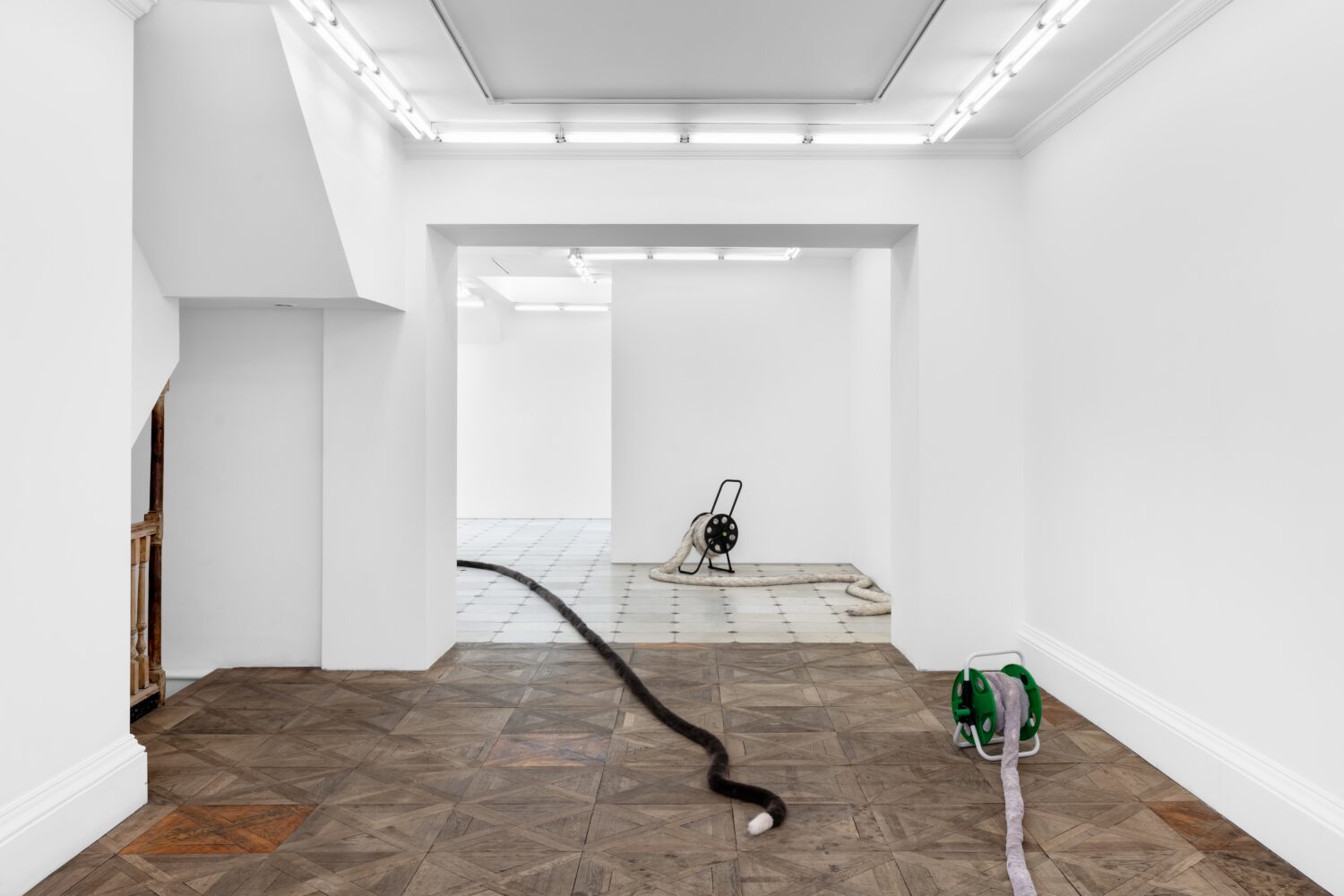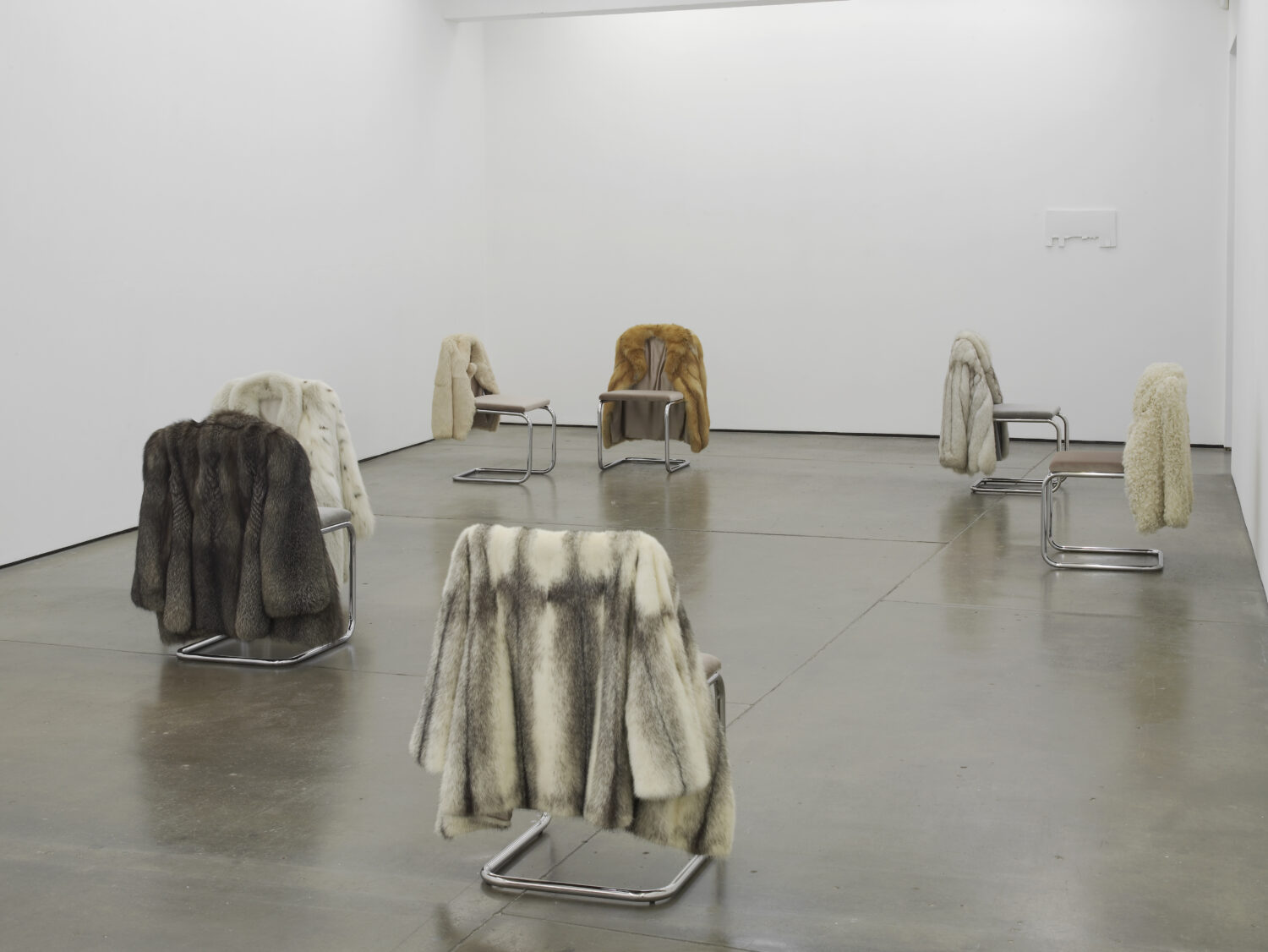Interview: In Conversation with Nicole Wermers
By Keshav AnandFor over two decades, London-based German artist Nicole Wermers has honed a singular sculptural practice that navigates the intersection of design, architecture, and the social politics of space. Known for her precise juxtapositions of found and fabricated forms, Wermers explores the structures that shape urban life and the hierarchies that govern bodily presence within them. Her work is marked by an incisive material intelligence and a subtle, often dark humour, rendering the rituals and objects of contemporary life uncanny and newly legible. The artist first came to my attention in 2015 with her Turner Prize–nominated exhibition Infrastruktur at Herald Street, which used altered modernist chairs and fur coats to probe ideas around class, consumption and control. Ten years later, at the gallery’s Bloomsbury outpost, her new exhibition Tails & Fainters extends her investigation into the physical and symbolic alignments of the body within space. Here, looping tails and fainting figures sprawl, slip, and strain against social codes.

Keshav Anand: You’ve described the faux-fur tails in your new exhibition at Herald St as “sculpture per metre.” I wonder if you could elaborate on this idea?
Nicole Wermers: I always liked the idea of a sculpture that could be in several rooms simultaneously, or at least has the potential to do so. Initially, I developed the Domestic Tails for an exhibition in an 18th-century palais in Moscow, where all rooms of the household had been converted into exhibition spaces, including the kitchen and servants’ quarters. I had this idea that certain bodies traverse architectural class differences within an aristocratic household with greater ease, like pets, but also artists. So the concept of the works was always connected to (architectural) hierarchies and the economics of space. When sewing these works at the studio, I was thinking a lot about the correlations between material, labour, value and space and “per metre” is a quantification alluding to both the value or price and also the potential space the work could extend over.
KA: To build on this, I understand each tail has been meticulously hand-sewn. What significance does this labour hold for you?
NW: It became apparent during production that the Domestic Tails would not look as good when made with a machine. But I also like the fact that doing this by hand is a slow process that adds to their presence. I am interested in speculating about how labour relates to value in artworks where conceptual gestures are priced in ways that do not relate to physical labour and how those relations may shift when you combine something handmade with something shop-bought.

KA: How do you decide when a found object can become a part of your sculptural language? I’m curious if there are some criteria or if this process of selection is intuitive.
NW: A lot of my work starts with taking photographs while walking through cities. It often takes years to realise that I am interested in a particular object category, for instance, baby changing units in public washrooms, which I ended up using for the Moodboards or the maintenance and service trolleys, upon which I placed the Reclining Females. What attracts me to certain objects is a mixture of their aesthetic and sculptural potential, the rituals we perform with them, and what I perceive as a structural significance with regard to the production and the hierarchies of space and how they relate to (female) bodies.
Sometimes my photography is more deliberate from the beginning. For a couple of years, I was taking portraits of croissants in cafes in various cities – croissants are great sculptural shapes, but when I was growing up in the ‘80s they were also early signifiers of gentrification, like avocado on toast is now. Unless it’s something else already? I ended up combining the croissant photographs with inserted pages of various sheets of international sandpaper in an artist’s book titled Croissants & Architecture.
KA: What interests you in the significance of fainting in art history and gender politics?
NW: I have been working with the sculptural possibilities of the non-vertical and the collapsing body quite a bit, most recently in the exhausted bodies of couples in my exhibition Marathon Dance Relief at Lismore Castle Arts, where a ceramic relief depicted endurance dancers leaning and collapsing into each other along an architectural frieze. Before that, I produced the aforementioned Reclining Females, oversized horizontal nudes resting on service trolleys in a position of strength.

Andrea Cavarero makes the feminist argument in ‘Inclinations’ that historically verticality, or uprightness – think Michelangelo’s David – is associated with independence, moral and intellectual superiority, while horizontality – i.e. a mother bending over a child caring for them, or someone exhausted, sleeping – instead hold connotations around care, dependence and vulnerability. The Fainters make a liminal state permanent. They’re frozen in transition, between the vertical and horizontal: diagonal, inclined. I think this archetype is interesting to revisit now because the exhaustion of these figures is not necessarily the result of something tangible and visible, but rather intangible and invisible.
The Fainters are clay sculptures of fainting women seemingly collapsing into the plinths that display them. They wear voluminous 18th and 19th-century dresses, when extravagant skirts – supported by elaborate wire frames and tight corsets – signified privilege, both through the labour required to produce them as well as the fact that they established a physical distance between the bodies inhabiting them to their surroundings (including other people). The dresses restricted blood flow, leading to actual fainting episodes, although fainting also became this massive fashion, involving highly stylized gestures. Women, especially of a certain class, were encouraged to appear delicate and distressed as a mark of refinement, particularly when exposed to public space and the newly developing urban realm.
KA: How do you think about the role of humour in your practice?
NW: The kind of humour I like, is not the “laughing out loud” one when you “get and forget” something in an instance. In fact, I prefer if an initial laughter becomes a bit unsure of itself when confronted with art. I liked the dark humour of Sigmar Polke, who was my professor at art school in Hamburg. He loved to joke about his paintings, which at the time were made from quite toxic materials. He imagined bourgeois families admiring his work on their Sunday morning museum visit, after which they would sit around their Sunday lunch table and suddenly all their hair would fall out.

KA: Looking back, in your 2015 show Infrastruktur, which remains an all time favourite of mine, how do you imagine the absence or presence of a body affecting the way space is read?
NW: Susanne Langer wrote about the volume created by sculpture, that it is space made visible, and more than the area the figure or work occupies – that resonates with me a lot. That sort of surplus of spatial presence is something I am after when making sculpture. Most of the works I made before the Reclining Females, rather than depict, imply the presence of a person, often referencing rituals and structures of the public realm and how these negotiate space in the urban environment. For instance, claiming a piece of public space by temporarily placing one’s jacket on a chair, as in The Violet Revs or the Untitled Chairs from the exhibition Infrastruktur you mention.
The thresholds between public and corporate space, marked by the security gates at the exit of department stores, which were a reference point for my Untitled Forcefields are another example. For the chair pieces, it was important that the jackets were sewn around them, turning a temporary gesture into something permanent. For the Untitled Forcefields, I wanted to communicate the invisible effect these devices emanate only through shape and material, not an actual electromagnetic field. I see those everyday objects and actions as possessing a structural significance, that I seek to amplify by carving them out of the everyday and playing with the layers of there-ness.

KA: Having previously collaborated with Balenciaga, what interests or interested you in exploring fashion as a context for your work?
NW: Clothing is very interesting to me because it is architecture on the body and also a code of social belonging and aspiration. Demna Gvasalia’s Balenciaga, especially at the time I was approached, was like me interested in the urban condition, it’s materialised hierarchies and different phenotypes, so I thought it could be interesting to do something in this context. I produced a series of sculptures doubling as displays for oversized Balenciaga puffer coats. Instead of single chairs like the Marcel Breuer ones I used for the Untitled Chairs, I decided to work with stacking and conference chairs, which neatly condense potential (seating) space into towers when stacked up. Depending on the different designs of each chair model, I developed various methods of permanently fusing the individual chairs of each stack, so it can’t be taken apart any more. Stacking chairs furnish public and corporate spaces and signify space as a flexible commodity. The space the chairs of the Untitled Stacks would be able to occupy when spread out, has irretrievably been piled up into vertical structures to befit the length and design of each of the coats.
KA: Changing pace for a moment, what are you currently listening to in the studio?
NW: Finger.
KA: And aside from home, where do you like to eat in London?
NW: The bar at St. John (Smithfields), Rochelle Canteen, Quo Vadis, Café Deco, Café Cecilia, Miga, La Bouche, Koya, and my friends Janice’ and Emma’s House.
Nicole Wermers’ Tails & Fainters is on view at Herald St, London until 28 June 2025.
Feature image: Nicole Wermers, Domestic Tail (Black / White Tip), 2025. © Nicole Wermers. Courtesy of the artist and Herald St, London. Photo by Jack Elliot Edwards